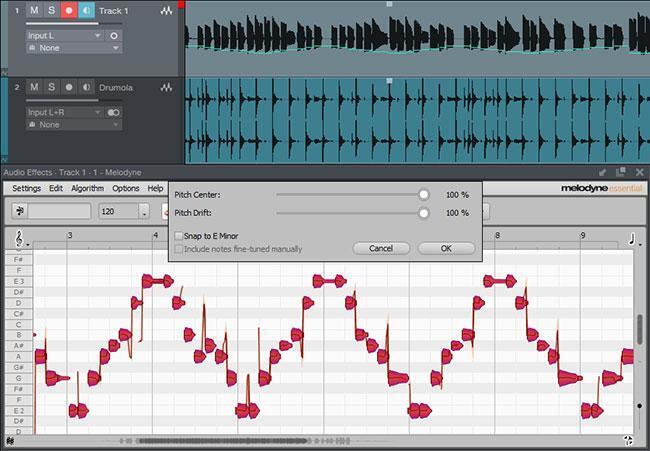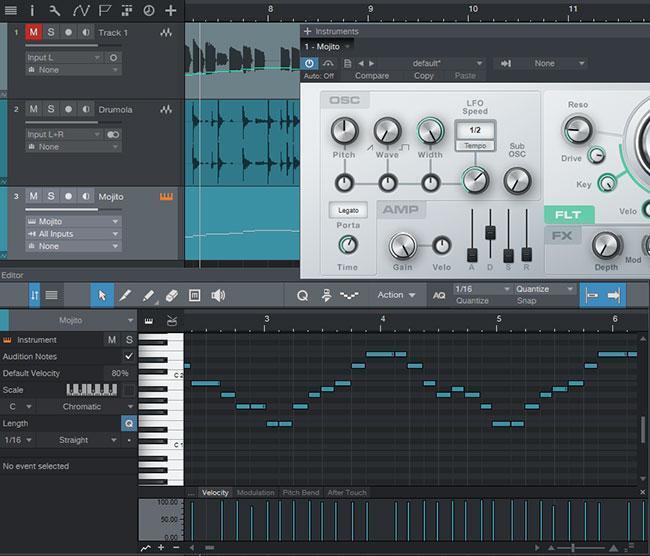
There are certainly enough keyboard players who want to sound like guitarists, but if you’re a guitar player, don’t you sometimes wish you could lay down a wicked synth bass part or a cool synth solo? Well, you can — and we’re not talking about MIDI guitar, divided pickups, or any new hardware. All you need is Melodyne (even the Essential version does the job for single-note melodies; for chords, you’ll need the Studio or Editor editions).
This works because Melodyne analyzes notes to determine their pitches, and it’s not much of a stretch to turn that info into MIDI note data. It helps to use recording software with ARA (Audio Random Access) integration, a protocol developed by Celemony and PreSonus — but as more and more programs are becoming ARA friendly, this isn’t much of a limitation. I’ll use PreSonus Studio One for my example here, but the concepts are the same in other programs.
Get Started
Let’s lay down a synth bass part, but with electric guitar. For best results, play cleanly. Use the neck pickup to avoid harmonics that could confuse the system (remember, Melodyne was originally designed for vocals). Still, it’s almost magical how well Melodyne turns your playing into data. If you’re even remotely careful, then you won’t need to clean up false triggers or glitches.
After recording the track, in Studio One, select the part and choose “Edit with Melodyne” (other programs may use different wording). You’ll see an overlay of piano-roll-style notes on the audio track and the Melodyne interface in its own window (fig. 1). While you’re at it, you might as well pitch-correct the notes… hey, why not? In the screenshot, all the notes are selected, and Pitch Center is set to 100% correction, so all the “bass” notes are spot on in terms of pitch.

Fig. 1: Track 1 with the guitar part opened for editing in Melodyne. You can see note data superimposed on the audio, as well as the “blobs” that represent notes in Melodyne’s editing window.
Get Bassy
Now insert a virtual instrument with your bass sound of choice (fig. 2 shows Studio One’s Mojito synth). Alt/Option+drag the bass clip into the instrument track; this discards the audio, so what’s left is only the note events. Press F2 to open up the instrument track’s editor, and you’ll see the note data.

Fig. 2: Track 1 has the guitar audio, track 2 is drums, and track 3 is the instrument track that feeds Mojito (peeking out from the right). The bottom screen is the editor for the note data.
The note data shows the raw part, before any kind of editing. The lack of glitches, tracking errors, doubled notes, etc., normally associated with playing MIDI guitar is notable. And now that the part has been converted into data, you can do all the fun data tweaks MIDI fans know and love — quantize the part, groove quantize it to the drums, edit velocity, and the like.
Yes, it really is that simple.
Take the Lead
You can do leads as well, but remember that Melodyne Essential will not translate pitch bends — you’ll need to add those yourself as edits or overdub a track with pitch-bend wheel motions. You can also wiggle the pitch-bend wheel to create “finger vibrato” (I often prefer that to LFO-generated vibrato).
Melodyne adds a powerful option for guitar players. So what if you can’t play keyboards? You can still lay down synth tracks, without needing to go the MIDI guitar route! Bonus: this same data can be imported into a notation program and used to create sheet music or lead sheets.







